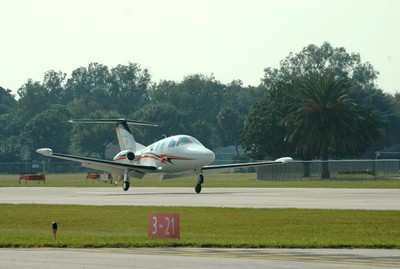Online Poll Shows Many Pilots Unfamilar With Proper
Procedures
by ANN Special Contributor Brad Whitsett, President, XWind
LCC
 (Editor's
Note -- ANN last checked in with the folks at XWind LLC at
AirVenture 2007, where
company president Brad Whitsitt presented a special forum with
information to help all pilots -- and, particularly, those with
low-time -- deal with a very common problem: how to properly handle
a crosswind on approach and landing. The company offers what it
calls the world's first special motion-based simulator,
specifically designed to boost crosswind landing skills.)
(Editor's
Note -- ANN last checked in with the folks at XWind LLC at
AirVenture 2007, where
company president Brad Whitsitt presented a special forum with
information to help all pilots -- and, particularly, those with
low-time -- deal with a very common problem: how to properly handle
a crosswind on approach and landing. The company offers what it
calls the world's first special motion-based simulator,
specifically designed to boost crosswind landing skills.)
Xwind, LLC conducted an online survey during 2007 to evaluate
pilot knowledge and confidence regarding crosswind landings. Here
are the conclusions that we reached by looking at the data
collected. For those pilots who took time to participate, we extend
our gratitude. We can’t guarantee that these results are
valid, but you may find these insights useful.
The survey asked for 17 identifying responses such as name,
flight time, highest certificate held, and number of crosswind
landings over 10 knots. It also asked for answers to 26 multiple
choice questions with four choices per question. The goal of all
questions was to identify a pilot’s technical knowledge of
crosswind landings, obtain a self evaluation of their own
performance regarding crosswinds, and to see if there were any
correlations to crosswind skill, confidence, flight time, or years
of experience, etc.
An automated grading system verified that responses were valid
and then scored the test and assigned an experience and confidence
score. It also calculated hours per year, hours per landing, and
total crosswind landing time in minutes. An imaginary 10,000 hour
ATP instructor with total confidence and high crosswind experience
was used as a standard to measure all participants. Nine experience
factors were used to produce a final experience rating.

Participants were reminded that the questions only apply to a
single engine, tricycle gear aircraft.
About the Participants
There were 136 valid participants included in the survey
database - 7 Student Pilots, 73 Private, 21 Commercial, 20
Instructor, 13 ATP, and 2 Sport Pilots.
Results
 We have done our best
to avoid reading too much into the results. But, we find the
following conclusion to be credible and interesting.
We have done our best
to avoid reading too much into the results. But, we find the
following conclusion to be credible and interesting.
A pilot must have over 3000 flight hours to routinely
rate themselves confident in a crosswind.
Pilots with over 3000 hours always rated themselves confident
with crosswinds. Under 3000 hours pilots might rate themselves
anywhere from low to high in their confidence. Pilots with less
than 3000 hours are more likely to need some help with crosswind
landings.
25% of pilots don’t know that bank angle
controls lateral position over the runway.
This was true for ATP rated pilots as well. As expected, student
pilots scored the lowest and instructors scored highest. Still, one
in four pilots could not identify this vital concept related to
crosswind landings.
All pilots surveyed know that if the wind speed
remains the same and wind direction changes, that the crosswind
component will change.
This one was surprising because other questions that seemed
easier were answered incorrectly. It is odd that this one is well
known but that bank angle control of lateral position is not well
known. It was great to see that even students knew this one.
However, it seemed odd that a pilot would know this and not know
the more vital issue that bank angle controls lateral position.
Private Pilots were the best at estimating crosswind
components correctly.
This one was very surprising. Private pilots scored better at
estimating crosswinds than, Commercial, ATP, and Instructors! The
questions asked what the component of crosswind would be at 30 and
45 degrees off the nose. ATPs scored half of what private pilots
scored. This could indicate that experienced private pilots must be
better at this because their equipment is more susceptible to the
wind.
64% of all pilots surveyed believe that an airplane
must be forced on the ground at high speed in a
crosswind.
This is one of the most significant flaws in crosswind landing
training and this survey seems to capture the concept. When given
the option in the answers, 64% of all pilots would choose to land
an aircraft at the “highest possible speed” in a
crosswind rather than slow down once the plane has neared the
runway. There is a strong belief that the aircraft should be
planted at high speed. This can lead to loss of control and yet the
majority of pilots would choose this method. Again, the questions
were only dealing with landing a light aircraft in a modest
crosswind (15 knots).
73% of all pilots refuse to go back airborne if the
aircraft demands it during touchdown.
If an aircraft touches down nicely in a crosswind and the wheels
are all on the ground and then a gust sends the airspeed way over
touchdown speed, the aircraft will announce this situation by
sliding downwind, lifting a main gear off the ground, and/or
porpoising. It would be best to encourage the aircraft to go back
to flight and back to the slip while the airspeed is high. Very few
pilots recognized that as an option in the questions. Answers
indicate that a large majority of pilots would press forward harder
on the yoke and hope that things calmed down before the aircraft
left the runway. It may indicate that this is the message being
delivered in training.
We strongly believe that this is a key factor that leads to loss
of directional control. When an aircraft is wings level on the
ground at high speed in a crosswind, it is not positioned to fly
and there may not be sufficient ground friction to steer.
Higher flight experience resulted in higher test
scores.
 This indicates that
pilots gain their technical understanding of crosswind landings
through trial and error and time more than from instruction. This
is why Xwind believes that a device is needed to provide that level
of technical insight, trial and error, and time to nail down
crosswind skill in a meaningful way.
This indicates that
pilots gain their technical understanding of crosswind landings
through trial and error and time more than from instruction. This
is why Xwind believes that a device is needed to provide that level
of technical insight, trial and error, and time to nail down
crosswind skill in a meaningful way.
Higher flight experience resulted in higher
confidence ratings.
This is exactly what was expected. Student pilots rated
themselves with much less confidence than private pilots and so on
up the experience scale. So, even if pilots pretended that they
were confident in the survey, on average, the results were exactly
what we would all expect. More flight experience results in more
confidence.
Summary
There could be other interesting facts to be gleaned from the
results. However, your eyes may be glazing over by now.
At Xwind, we believe that there is a better way to impart a high
level of skill, technical knowledge, and confidence without risking
aircraft to get it done. Since crosswinds are the number one cause
of weather related accidents, we believe that our trainer is the
answer that will help pilots identify areas to improve and provide
them with the tool to do it in complete safety.
At Xwind, we expect to improve how crosswind skill is obtained
and maintained and to make this technology available at an
affordable cost.
 ANN's Daily Aero-Linx (04.13.24)
ANN's Daily Aero-Linx (04.13.24) ANN's Daily Aero-Term (04.13.24): Beyond Visual Line Of Sight (BVLOS)
ANN's Daily Aero-Term (04.13.24): Beyond Visual Line Of Sight (BVLOS) Airborne 04.09.24: SnF24!, Piper-DeltaHawk!, Fisher Update, Junkers
Airborne 04.09.24: SnF24!, Piper-DeltaHawk!, Fisher Update, Junkers Aero-News: Quote of the Day (04.14.24)
Aero-News: Quote of the Day (04.14.24) ANN's Daily Aero-Term (04.14.24): Maximum Authorized Altitude
ANN's Daily Aero-Term (04.14.24): Maximum Authorized Altitude






